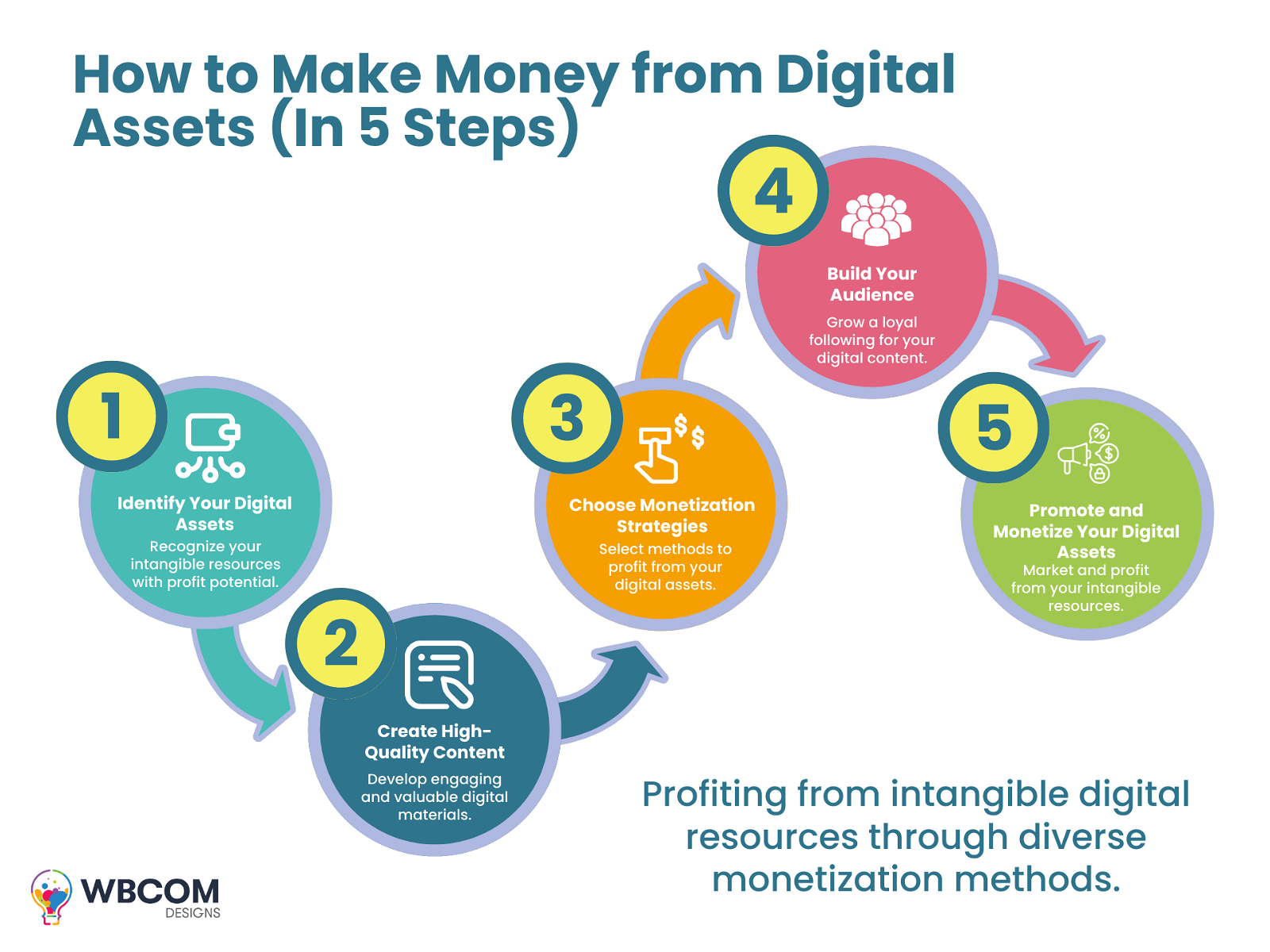Digital Assets represent a wide array of intangible assets in the digital realm, encompassing everything from ebooks and online courses to digital artwork and photography. These assets hold immense value in today’s digital age, serving as valuable resources for individuals and businesses alike. Monetizing digital assets has become increasingly crucial, offering creators and entrepreneurs the opportunity to capitalize on their intellectual property and expertise.
Whether it’s generating passive income streams or building a thriving online business, the ability to monetize digital assets opens up new avenues for financial growth and success. In this blog, we’ll explore the significance of digital assets and delve into effective strategies for monetizing them, empowering creators and businesses to unlock their full potential in the digital landscape.
Table of Contents
ToggleMaking Money From Digital Assets

Step 1: Identify Your Digital Assets
Digital assets encompass a broad spectrum of intangible assets that exist in digital form. These assets can range from content and creative works to data and intellectual property stored electronically. Essentially, any digital file or piece of online content that holds value or serves a purpose can be considered a digital asset. This includes but is not limited to ebooks, online courses, digital artwork, photographs, videos, music, software, databases, social media accounts, domain names, and cryptocurrency. New York logo design company has worked with entrepreneurs to help them develop their brand identity through design.

Examples of digital assets
- Ebooks: Digital books or guides that are distributed electronically, often in PDF or EPUB formats. Ebooks can cover a wide range of topics, from fiction and non-fiction literature to instructional guides and tutorials.
- Online courses: Interactive educational programs delivered via the Internet, typically consisting of video lessons, quizzes, assignments, and other learning materials. Online courses cover various subjects and skill levels, catering to learners seeking personal or professional development.
- Photos: Digital images captured and stored in electronic format, commonly used for creative projects, marketing materials, and website content. Photographs can include stock photos, original artwork, product images, and visual content for social media.
- Videos: Multimedia content consisting of moving images and audio, created for entertainment, educational, or promotional purposes. Videos can range from short clips and tutorials to full-length films and documentaries, accessible on platforms like YouTube, Vimeo, and social media.
- Music: Audio recordings and compositions distributed digitally through streaming platforms, digital downloads, or licensing agreements. Digital music encompasses a wide range of genres and formats, including singles, albums, soundtracks, and podcasts.
- Software: Digital programs and applications designed to perform specific tasks or functions on electronic devices. Software includes both commercial and open-source applications, ranging from productivity tools and games to operating systems and mobile apps.
- Databases: Structured collections of data stored electronically, organized for efficient retrieval and manipulation. Databases can contain various types of information, such as customer records, product catalogs, inventory lists, and research datasets.
- Social media accounts: Online profiles and accounts on social networking platforms, including Facebook, Twitter, Instagram, LinkedIn, and TikTok. Social media accounts can serve as valuable digital assets for businesses, influencers, and individuals, offering opportunities for engagement, promotion, and monetization.
- Domain names: Unique web addresses that identify specific websites or online resources on the internet. Domain names can be bought and sold as digital assets, with valuable domains commanding high prices based on factors like brand-ability, keywords, and extension.
- Cryptocurrency: Digital or virtual currencies secured by cryptography and decentralized blockchain technology. Cryptocurrencies like Bitcoin, Ethereum, and Litecoin serve as digital assets for investment, trading, and peer-to-peer transactions in the digital economy.
Identifying and understanding your digital assets is the first step towards leveraging them effectively for monetization and financial gain.
Step 2: Create High-Quality Content
Quality content is vital for successful digital asset monetization. It builds credibility, trust, and authority, positioning you as a reliable source of valuable information or entertainment. Engaging content attracts and retains audiences, driving traffic and encouraging sharing. Additionally, it enhances the user experience, leading to increased retention and improved conversion rates. Quality content is essential for establishing a strong presence in the digital space and maximizing monetization potential.

Tips for Creating Compelling Digital Content
- Know Your Audience: Understand your target audience’s interests, preferences, and pain points to create content that resonates with them.
- Provide Value: Offer valuable insights, solutions, or entertainment that address your audience’s needs and add tangible benefits to their lives.
- Be Authentic: Stay true to your voice, personality, and brand identity to establish authenticity and connect with your audience on a deeper level.
- Focus on Visual Appeal: Incorporate eye-catching visuals, such as high-quality images, videos, and graphics, to enhance the visual appeal and engagement of your content.
- Keep it Engaging: Use storytelling, interactive elements, and multimedia to keep your audience engaged and captivated throughout their interaction with your content.
- Optimize for SEO: Incorporate relevant keywords, meta tags, and SEO best practices to optimize your content for search engines and improve its discoverability.
- Maintain Consistency: Consistently publish high-quality content regularly to keep your audience engaged and coming back for more.
- Encourage Interaction: Encourage comments, shares, and feedback from your audience to foster a sense of community and engagement around your content.
- Test and Iterate: Continuously monitor the performance of your content, analyze audience feedback, and experiment with different formats and approaches to refine and improve your content over time.
Also Read: Navigating the Social Wave: The Rise, Impact, and Future of Social Networking
Step 3: Choose Monetization Strategies
Overview of Different Monetization Methods
- Advertising: One of the most common monetization methods is displaying advertisements on digital assets, such as websites, blogs, or social media platforms. This can include banner ads, sponsored content, or video ads. Publishers earn revenue through pay-per-click (PPC) or pay-per-impression (PPM) models, where advertisers pay for clicks or impressions on their ads.
- Affiliate Marketing: Affiliate marketing involves promoting products or services and earning a commission for each sale or action generated through your referral. This method is popular among bloggers, influencers, and content creators who recommend products or services to their audience. Affiliate marketers typically use unique tracking links to track referrals and commissions.
- Selling Products/Services: Another effective monetization strategy is selling digital or physical products/services directly to your audience. This could include ebooks, online courses, digital artwork, software, consulting services, or physical merchandise. Creators can set up e-commerce platforms or use third-party marketplaces to sell their products/services.
Also Read: How to Start and Monetize Your Blog: A Comprehensive Guide

Factors to Consider When Choosing Monetization Strategies
- Audience Profile: Understand your audience’s demographics, interests, and preferences to choose monetization methods that align with their needs and behavior. For example, if your audience is tech-savvy and prefers digital products, selling online courses or software may be more lucrative than physical merchandise.
- Content-Type: Consider the type of digital assets you’re monetizing and how different monetization methods may complement or detract from the user experience. For instance, intrusive ads may disrupt the reading experience on a blog, whereas affiliate marketing recommendations may feel more natural and relevant.
- Revenue Potential: Evaluate the revenue potential of each monetization method based on factors such as commission rates, advertising CPMs (cost per thousand impressions), product pricing, and market demand. Choose strategies that offer the highest potential for generating consistent and sustainable income.
- Long-Term Sustainability: Consider your chosen monetization strategies’ long-term sustainability and scalability. Focus on building diversified revenue streams that are resilient to changes in market trends, algorithm updates, or industry disruptions.
- Alignment with Brand Values: Ensure that your chosen monetization methods align with your brand values, mission, and audience expectations. Transparency and authenticity are key to building trust with your audience and maintaining credibility as a content creator or business owner.
By carefully considering these factors and exploring different monetization methods, creators and businesses can develop effective strategies to monetize their digital assets and maximize their revenue potential.
Also Read: Design engaging experiences in insurance mobile apps through gamification techniques
Step 4: Build Your Audience
Audience engagement is crucial for the success of any venture involving digital assets. Engaged audiences are more likely to interact with your content, share it with others, and ultimately, contribute to your revenue streams. By fostering a sense of connection and community with your audience, you can build brand loyalty and trust, which are essential for long-term success. Engaged audiences also provide valuable feedback and insights that can help you refine your digital assets and improve your offerings over time.

Strategies for Attracting and Retaining an Audience
- Consistent Content Creation: Regularly produce high-quality content that resonates with your target audience’s interests and needs. Consistency builds anticipation and keeps your audience engaged.
- Use Multiple Platforms: Expand your reach by leveraging various digital platforms such as social media, blogs, podcasts, and video channels. Diversifying your presence allows you to connect with different audience segments and cater to their preferences.
- Interact and Respond: Actively engage with your audience by responding to comments, messages, and inquiries. Show genuine interest in their feedback and suggestions, and foster two-way communication.
- Offer Value: Provide valuable content, insights, or entertainment that enriches your audience’s lives. Solve their problems, answer their questions, and address their pain points to establish yourself as a trusted authority in your niche.
- Build Community: Create opportunities for your audience to connect with you. Host live Q&A sessions, webinars, or online forums where they can interact, share experiences, and learn from each other.
- Personalize Experiences: Tailor your content and communications to the specific interests and preferences of different audience segments. Personalization enhances engagement and strengthens relationships with your audience members.
- Measure and Analyze: Use analytics tools to track audience engagement metrics such as likes, shares, comments, and click-through rates. Analyze the data to identify trends, understand audience behavior, and refine your strategies accordingly.
By prioritizing audience engagement and implementing these strategies, you can effectively attract, retain, and grow your audience, laying a solid foundation for monetizing your digital assets successfully.
Step 5: Promote and Monetize Your Digital Assets
Marketing Tactics to Promote Digital Assets
To effectively monetize your digital assets, it’s essential to implement robust marketing tactics to promote them to your target audience. Here are some effective strategies:
- Content Marketing: Utilize content marketing to create valuable and engaging content related to your digital assets. This can include blog posts, social media content, videos, webinars, and more. By providing valuable insights, tips, and information related to your digital assets, you can attract and engage your audience while subtly promoting your products or services.
- Social Media Marketing: Leverage the power of social media platforms to reach and engage with your audience. Share regular updates about your digital assets, including sneak peeks, behind-the-scenes content, customer testimonials, and promotions. Engage with your followers by responding to comments, asking questions, and encouraging user-generated content.
- Email Marketing: Build and nurture an email list of subscribers interested in your digital assets. Send out regular newsletters, updates, and promotional emails to keep subscribers informed about new releases, special offers, and exclusive content. Personalize your emails based on subscriber preferences and behaviors to improve engagement and conversion rates.
- Influencer Marketing: Collaborate with influencers and industry experts in your niche to promote your digital assets to their followers. Identify influencers whose audience aligns with your target demographic and negotiate partnerships for sponsored content, reviews, or shoutouts. Influencer endorsements can help increase the visibility, credibility, and sales of your digital products.
Also Read: Top WordPress Sidebar And Widget Plugins

Implementing Chosen Monetization Strategies
- Advertising: Monetize your digital platform through display advertising using networks like Google AdSense.
- Affiliate Marketing: Partner with relevant brands and earn commissions for promoting their products or services to your audience.
- Selling Products or Services: Offer digital products or services for sale directly to your audience, such as ebooks, online courses, or memberships.
- Subscription Models: Implement subscription-based monetization models to generate recurring revenue from your digital assets.
Optimize for Conversion
- Create compelling sales pages and calls to action to drive conversions.
- Test and optimize your marketing tactics and monetization strategies to maximize revenue.
- Use analytics to track performance and identify areas for improvement.
Engage with Your Audience
- Respond to comments and feedback from your audience to foster engagement and build relationships.
- Encourage user-generated content and participation to enhance community engagement.
Stay Updated and Adapt
- Keep abreast of industry trends and changes in consumer behavior to adapt your marketing and monetization strategies accordingly.
- Continuously innovate and iterate on your digital assets to keep them fresh and relevant to your audience.
By implementing these strategies effectively, you can promote and monetize your digital assets successfully, driving revenue and achieving your business goals in the digital space.
Conclusion
In conclusion, monetizing digital assets offers a promising avenue for individuals and businesses to generate income and achieve financial success in the digital age. Throughout this guide, we’ve outlined five key steps to effectively monetize digital assets, from identifying and creating high-quality content to implementing marketing tactics and monetization strategies. By following these steps, creators and entrepreneurs can unlock the full potential of their digital assets and capitalize on their intellectual property and expertise.
I encourage readers to explore the diverse opportunities for monetization available in the digital landscape and to leverage their creativity and ingenuity to create valuable assets that resonate with their audience. Ultimately, the potential of digital asset monetization is vast, and with the right approach and determination, individuals and businesses can thrive in the competitive digital marketplace.
Interesting Reads:
Best Sales Desk Alternatives In 2024








